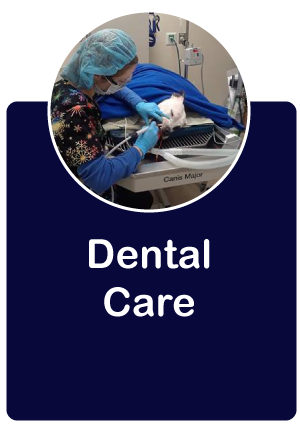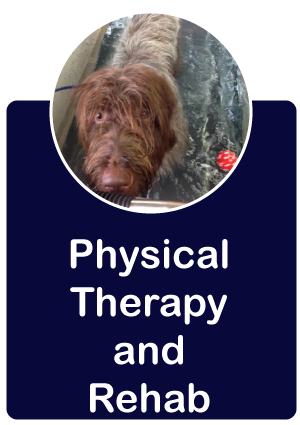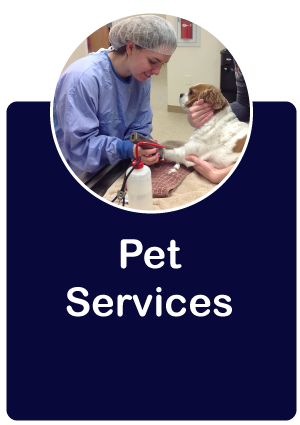|
Puppy Education
CONGRATULATIONS on your newest family member! There are a few things to remember about the care of your new puppy. Your puppy will need to continue to have vaccine boosters every 3 weeks until 4 months of age. Your veterinary technician will go over all of the available vaccines with you while you are here for your visit. You can also visit our "Wellness Vists" page to look at all of your options. The entire vaccine series must be completed before your pup is considered to be immune. In the meantime your dog can still get sick with these diseases until 2 weeks after the final injection of the series. We will also continue to discuss potty training and other behavior issues at your recheck appointments.
Spaying/neutering is also something you need to think about when you get a new puppy. Spaying/neutering can take place starting at 4 months of age. We typically can combine this surgery procedure with the last round of the vaccine series. Research shows that spaying reduces your dog's risk of mammary tumors by up to 97%. Pyometra (infected uterus) is completely eliminated. Prostate cancer, testiclar cancer, and benign, enlarged prostate are virtually eliminated in male dogs. Other endocrine, allergic and immune-mediated problems are lessened without the hormonal stimulation of intact dogs. Male dogs are also less aggressive and less prone to roam and, therefore, to be victims of trauma such as being hit by a car.
We recommend monthly preventatives to treat for the most common parasites seen in veterinary medicine. Fleas, ticks, heartworm, and intestinal parasites can all be easily controlled with safe effective products. These products include things like Frontline Gold, Nexgard, Bravecto, Heartgard Plus, Interceptor Plus, Sentinel, Trifexis, and Scalibor collars. Ask for details about these preventatives and we can help you to decide what the best option for your pet may be.
House Training
Just as in potty training a human child, patience, perseverance and consistency are necessary in house training a puppy. The basic theory of house training is to promote the opportunity for the pet to relieve her/himself in the proper location and to prevent the possibility of the pet to soil the house. A dog is able to hold its urine and bowel movements for eight to twelve hours; whether or not he/she can learn to is up to you!
Helpful Tips/Facts:
- Pick a verbal cue for going to the bathroom, such as "Go potty," or "Let's be a good girl/boy".
- Set up a regular schedule for your puppy, including mealtime, playtime, crate time and bathroom time.
- As a general rule of thumb, 8-12 week old pups need to go out every 1-2 hours. 12-16 week olds need to go out every 2-3 hours.
- Puppies should be taken outside to eliminate after waking up from sleep/nap, after eating, after playtime, after drinking water, when he/she gets excited or "tells" you he/she has to go out by circling or sniffing and then every 1-3 hours in between depending on her/his age. The dog should always be asked to "sit-stay" before putting on the Leash and taking them out to eliminate. Always put the leash on before going out! Don't take off the leash or play until the dog does its business, otherwise he/she will learn how to get you outside to just play or become distracted, instead of focusing on going to the bathroom.
- If your puppy is very small, you can pick the dog up and carry her/him out at the beginning.
- Take him/her to the same area of the yard each time. Use your verbal cue gently and calmly. At first, this will mean nothing to him/her, but after a few weeks, he/she will start to understand, especially when followed by warm, sincere praise.
- Keep their bathroom clean except for the most recent stool. Many dogs need to sniff a previous bowel movement to remind them what they need to do.
- If you have taken the puppy out and he/she does not relieve him/herself within 10 minutes, bring her/him back in and put her/him in her crate or keep her/him on a leash with you in the house and take her/him back out in about 20 minutes. Do not let the dog wander through the house unsupervised after an unproductive trip outside. Eventually, it should only take the dog about 10 minutes to do her/his business.
- Rewards go a long way. Praise, praise, praise your puppy for going! Don't rush or frighten her/him. Don't yell or threaten her/him.
- At the beginning, feed your puppy three to four times a day, letting her/him eat what she/he can in about 10 minutes. Gradually taper to twice a day when your puppy is four to six months old. Do not leave food out all the time! Your puppy will become overweight, the food may spoil, and she will have problems with house training. Once he/she reaches its adult weight, you will feed your dog a "prescribed" amount twice a day.
- Do not feed table scraps.
- High quality/protein foods produce fewer stools. You get what you pay for!
- Clean house training accidents with an odor neutralizer, such as Nature's Miracle®. Many household cleaners contain ammonia, also found in urine, which will only confuse your puppy.
Basics of Crate Training
It is important to understand that the crate is not a cage or jail. A crate is your puppy's own place to seek refuge and peace-a place to hide toys, take naps and to get away from it all during times of activity or stress in the household. Puppies like to sleep in small, close places. That's why they curl up under the bed or chair. A create allows you to use this instinct as a training tool. Begin by choosing a crate type and size to suit your dog.
Crate Size:
The crate should be large enough for the puppy to standup, stretch, turn around and lie down comfortably, with a little growing room. If the crate is too large, the pup can relieve herself in a far corner and still have a clean bed. Remember, one of the purposes behind using a crate is to use her instinct to keep her bed clean.
Introducing the Crate:
Introduce the pup to the crate by tossing a treat inside while the pup is watching. Say, "(Name), crate!" in a positive, upbeat way and urge the puppy inside. Let the pup grab the treat and come back out. Repeat this a couple of times. Later, place the puppy's dinner inside the crate. Let her eat with the door open, coming and going as she pleases. When the puppy is comfortable going in and out, toss a treat inside the crate, close the door, wait a couple of minutes, then open the door. Gradually increase the time until the puppy is comfortable with the door being closed. A puppy can be crated for up to four hours if you are leaving the house. Be sure to remove the collar and tags, which can get caught. If your puppy throws a temper tantrum when you close the door, do no let her out until she is quiet. If you let her out when she is whining, you will teach her that whining works! Instead, tell her "No. Quiet." in commanding tone of voice. During the day, place the crate near people, such as the kitchen or family room. Let your pup see and hear the normal sights and sounds of the household.
Bedtime:
No food for two hours before and no water for one hour before bedtime. Take the puppy outside for a potty trip last thing before placing him/her in the crate. Show no attention to the puppy once it is placed in the crate, otherwise he/she will learn how to seek "negative attention." For the first few nights, you may want to place the crate in a different room where you can close the door. You will need to set your alarm to let the puppy out at least once during the night. Once the puppy has learned to stay quiet, many people prefer to move the crate to the bedroom. Later, after the puppy is completely trained, many people will leave the door of the crate open and use this as the permanent bed for the dog. Most puppies will make it through the night without accidents if they are confined, but, get them out immediately upon waking. The fact that the puppy can go 8 hours at night does not mean it is ready to go eight hours during the day.
Preventing Problems:
As your dog matures, she can be given more freedom. If she does make a mistake, return to using the crate. The dog must prove her/his reliability by not having accidents in the house and by not getting into trouble. Too much freedom too soon will result in problems. Your dog will still use the crate on its own, even when fully grown. For example, he/she may retreat there when the family is busy and he/she needs to sleep. He/she may use it as a place to keep their toys. The crate will come in handy when you travel or when your pup needs to be boarded. And teaching the pup to ride in the crate in the car may save his/her life one day.
Puppy Training
Dogs, like people need training to learn how to behave appropriately. More importantly, training your dog can save its life. Chewing on your shoe because your dog is bored is one thing, but chewing on an electrical cord can end his/her life. More dogs are euthanized every year due to behavior problems than due to any other health problem. So, if dogs are to reach their full potential as healthy, loving, lifelong companions, they, and we as owners, need a little help.
Puppy hood is the best time to start your dog down the right path. Puppy training classes are ideal, but at least follow these tips at home:
- Teach your puppy the adage "Nothing in life is free." Teach to "sit" before feeding her/him or before putting on its leash to "go out and be a good dog." Make sure to reinforce good behavior with lots of positive praise or even with a very small food treat. Try to ignore bad behavior that the puppy is engaging in to get negative attention - it's hard to do at the time, but well worth it in the long run.
- Use a Promise, Halti, or Gentle Leader behavioral collar beginning at 3-4 months of age. These collars are completely humane and endorsed by the SPCA.
- Provide your dog with a crate, a safe place that's all his/her own. Your dog will regard her/his crate as her/his den or sanctuary. Gradually, you will help your puppy to learn that the entire house is an extension of her/his den.
- Feed a high-quality diet on a regular schedule, at least two times a day. Hills Science Diet, Royal Canin, and Purina Pro Plan are all great diets to consider for your family member. Always feed him/her in a quiet place, safe from the "threat" of another dog. Your dog will soon realize that life is good in your household, or "pack" and he/she will naturally grow to respect and to defer to you.
- Take your puppy for a walk every day, even if you have a large fenced in area where he/she has free access. Nothing can substitute for getting out and about and checking out the world beyond his/her own yard. Take some time to play with your puppy, too. All of these ideas are designed to relieve your dog of boredom, so that he/she gets its mind off of chewing your woodwork.
- Spay or Neuter!!!!! Don't fall for the old myths that sterilization makes him "less of a man" or her "fat and slouchy." Males will roam less and become a bit more manageable without all that testosterone. And your female's purpose in life will be to please you, not her puppies.
Preventing Behavior Problems
Appoint Yourself Leader of the Pack. Today's behavior training is based on using the dog's natural desire to be member in good standing of your pack. If a dog senses that the pack has no leader, he/she will follow nature's law and try to fill that position his/herself. In the dog world, leadership goes to whoever claims and holds it. So be sure to declare yourself "The Leader” and your dog will be more than happy to go along with the idea. For example:
- When you and your dog are entering or leaving a room, you go first. Have your dog sit and wait for your permission to follow you every time.
- When you and your dog are going for a car ride, put her in "sit-stay" until you give her permission to get in. Do the same thing when exiting.
- Eat first. Then have her "sit-stay" while you fill her bowl on the counter and then present it to her. Practice obedience, such as "sit-stay-come" at least 15 minutes a day, away from distractions.
- Although tempting, resist for now allowing the dog on your bed or sofa. This is a privilege he/she will perceive to be a sign of equality with you, the leader. Save this treat for later, once he/she has caught on.
- Play appropriately with your dog. For example, don't play tug-of-war because that can play into his/her desire to be dominant. When you eventually let go of the toy, your dog will think he/she is stronger than you are, and therefore that he/she is leadership material in the making. If there are children in the household, don't allow them to roughhouse with the dog, because he/she may perceive this as a battle for dominance. If the dog jumps up and tries to nip at their hands or faces, instruct the kids to keep their hands tucked behind their backs and not to run or scream. These are an "invitation" to your dog to step up the "fun." And don't let your dog lick your face, or anyone else's, straight on. This can also be a way of challenging leadership.
- Don't give in to a dog who demands play, food or petting. If he/she gets pushy, cross your arms, turn your head up and to the side away from your dog. If he/she counters by moving to your other side, turn your head the other way. This is a good habit to get into, especially if your dog tends to be pushy and dominant.
Puppy Classes
Enrolling your pet into puppy classes is a great way to help with training and socialization. Below are some of the local behaviorist/Trainers we recommend.
|
Knucklehead Professional Dog Training
718 15th St, New Cumberland, PA 170710
717-775-9339
|
The Hound Works
2528 Brownsville Rd, Robesonia, PA 19551
610-400-3139
|
|
Lebanon County Kennel Club
1594 Cumberland St #117, Lebanon, PA 17042
717-272-6322
|
PetSmart
11125 Quentin Rd, Lebanon, PA 17042
717-273-8070
|
|
Good Dog 101
4677 Irish Creek Rd, Bernville, PA 19506
610-488-5279
|
Godfrey's Welcome To Dogdom
4267 New Holland Rd, Mohnton, PA 19540
610-777-5755
|
To find a dog trainer near you: Certification Council for Professional Dog Trainers
|






